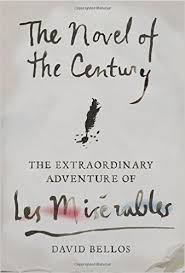David Bellos
Farrar, Straus and Giroux

|
Valjean does not represent directly any particular political or religious position. What he models is the potential that the poorest and most wretched have to become worthy citizens. His repeated victories over physical, moral and emotional obstacles make him a hero, of course, but they also assert, against the attitudes prevalent at the time, that moral progress is possible for all…It is not a reassuring tale of the triumph of good over evil, but a demonstration of how hard it is to be good. from The Novel of the Century |
Writing to change the way we see the world.
The century is the nineteenth, and the “novel of the century” is Victor Hugo’s Les Misèrables. Even if you haven’t read this gargantuan work (at 1500 pages, it makes Moby Dick look like a quick read,) you have probably seen one of its many film, stage, or TV adaptations, or the hugely popular musical, Les Mis.
One might wonder at other contenders for the title of Novel of the Century: say, War and Peace (1863-1868,) The Brothers Karamazov (1879-1880,) or even more provincial, less epic works like Madame Bovary (1857,) Middlemarch (1871-72) and Adventures of Huckleberry Finn (1885.) Or maybe one of the novels by that Dickens fellow. But it is the story of Jean Valjean, imprisoned for stealing a loaf of bread to feed his sister and her children, that remains for many the seminal epic of social injustice and misères.
Victor Hugo, admired as the greatest writer of his day and already famous for his poetry, dramas, and historical novel, The Hunchback of Notre-Dame, published his masterpiece in 1862. He was one of the most progressive thinkers of his age, opposing the death penalty and advocating for child labor laws, and active in the turbulent politics of his times as a true republican. He also traveled openly with his wife and his mistress (Oh, those French!)
For writers like Hugo, what’s important is that their writing makes a difference. Maybe changes minds and the way people see the world—Not an easy task since most of us prefer our world views corroborated rather than changed.
In the eighteenth and nineteenth centuries, the poor were considered not as products of their circumstances but as a separate criminal class. Hugo, like Dickens across the Channel, put a human face to the poor. Fantine the prostitute, Cosette the orphan, Valjean the convict, all became sympathetic characters with whom the reader could identify and care about. It’s much easier to deny food stamps to “the poor” in the abstract; much harder when you see the actual child and the single mother working two part-time jobs who you’re denying food stamps to.
What’s amazing is that 155 years after Les Miserables was published, many of the same attitudes toward the poor operate in our society today: that they are lazy, they are criminals, they are irredeemable. Jesus said the poor will always be with us, and I suppose, so will such attitudes toward them. May there always be a Victor Hugo to remind us that the poor have human faces.
This review first appeared in The Columbia River Reader (August 15-September 14, 2017.) Reprinted with permission.



